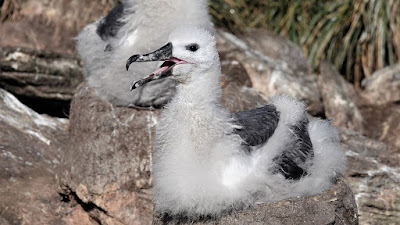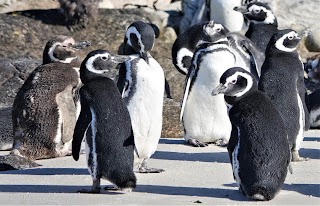“ … the land is low and undulating with stony peaks and bare ridges; it is universally covered by a brown wiry grass, which grows on the peat”. The whole landscape … has an air of extreme desolation…This is one of the quietest places we have ever been to”. Charles Darwin
We weren’t thinking too much about the Falkland Islands, since we were expecting South Georgia to be the jewel in the crown of wildlife and scenic beauty in this part of the South Atlantic. So, what a pleasant experience we found it to be, unlike Darwin’s visit!
Our first landing was in the west part of the Falklands archipelago on New Island. We enjoyed a pleasant walk across spongy peat bogs and low vegetation to the top of a hill. There were wide horizons since trees do not grow here and obstruct the views. The weather was mild and sunny, almost balmy after Antarctica. A vast rookery of Rockhopper Penguins and Black-browed albatrosses stretched vertically along the sea cliffs which plunged dramatically to the ocean below. The birds were all mixed up together on the rocks—the albatross chicks sat on their round clay nests and the penguin chicks stood in between and all around. Both chicks were patiently waiting for their parents to bring back food from the sea.
The albatross babies were testing their wings, and in another month or two will be able to take off and fly on their own. They are pelagic seabirds and will not appear on land again for 7-9 years when it’s time for them to breed and have their own chicks. A single egg per pair is incubated for 71 days before it hatches. As we watched the adults fly in to feed the babies, all we could say was “WOW” every time they flew over us. Their wingspan ranges from 79”-94”, and it’s awe-inspiring just to watch them soar. Albatross are also monogamous and wait patiently each year for their mate to appear. When this happens, they erupt into a ritual dance seeming to celebrate their safe return.
 |
| Black-Browed Albatross Chicks |
The Rockhopper Penguins are called that name for a good reason. When one sees the sheer vertical incline hundreds of feet above the sea, it seems impossible that a penguin could hop so high to raise chicks when it has to feed them by returning to the sea to fish and then make the climb all over again. But their legs are strong, and their feet have sharp claws to help. These penguins are listed as vulnerable. Their numbers have been declining due to overfishing and pollution.
 |
| Rockhopper Penguin |
On the periphery of these two major rookery species were several striated caracaras. They are a bird of prey and very spunky. They don’t shy away from tourists, but sometimes approach them. They look at us as if to say, “maybe today will be interesting since we can watch all of these aliens making noise and milling around us.” They scavenge for food and have been listed as a threatened species.
 |
| Striated Caracara |
 |
| Skua |
Another interesting stop in the Falklands was West Point Island. The same albatrosses and penguins were found there along with Magellanic Penguins, oystercatchers, steamer ducks, kelp and upland geese, and heron. Enroute between the 2 islands were numerous rafts of sea lions swimming together and leaping out of the water like dolphins. One group actually was a pod of dolphins of unknown species, since they didn’t come far enough out of the water to identify them. It turned out that the wildlife in the Falklands didn’t disappoint us but was rich and alive.
 |
| Magellanic Penguins |
 |
| Blackish Oystercatcher |
 |
| Steamer Ducks |
 |
| Male and Female Kelp Geese |
 |
| Male and Female Upland Geese |
 |
| Night Heron |
Port Stanley is the capital of the Falklands. It is considered a BOT, British Overseas Territory. It is entirely self-governing, and no taxes are paid to Britain. However, Great Britain does provide defense and foreign policy. The town has about 2,500 residents. Some were born there; others came from somewhere else but have chosen to become residents, and others are there just to work for a time and leave. The city is very English, down to its cottages, gardens, pubs and right-hand drive vehicles. One cannot visit here without recounting the many memories of its citizens during the Falklands War with Argentina in 1982. On the Argentina side, we saw many signs which held that the Falklands or Malvinas (in Spanish) do belong to Argentina. This dispute has not died and may even intensify in the future as oil has been discovered in the waters surrounding the Falklands.
 |
| Governor's House |


